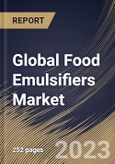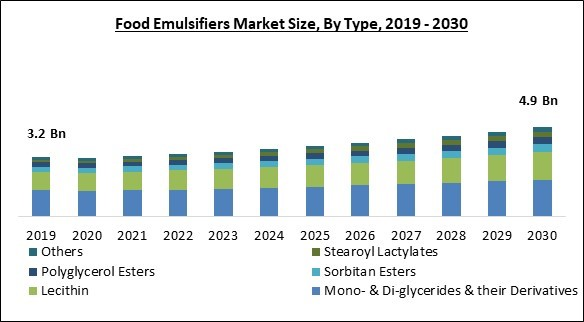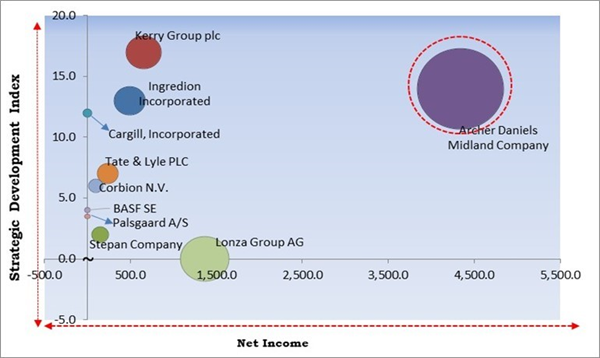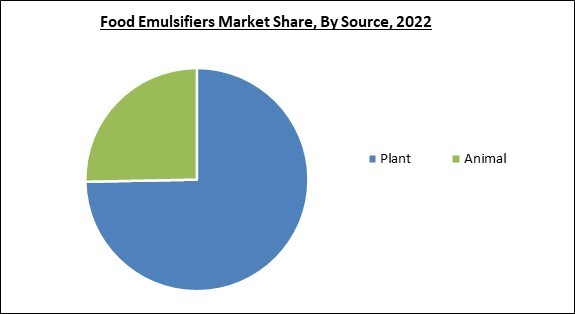The Global Food Emulsifiers Market size is expected to reach $4.9 billion by 2030, rising at a market growth of 4.7% CAGR during the forecast period.
Convenience foods are gaining traction among the working population because of the increased consumer expenditure on packaged goods, along with the increasingly busy lifestyles of consumers in both developed and developing nations. Hence, the convenience foods segment accounted for $567.8 million revenue in the market in 2022. Also, as consumers nowadays are more interested in vegan convenience foods, demand for plant sourced emulsifiers is growing.
The major strategies followed by the market participants are Acquisitions as the key developmental strategy to keep pace with the changing demands of end users. For instance, In November, 2022, Cargill, Incorporated acquired Owensboro Grain Company to enhance the its effort to increase capability across its North American oilseeds network to support the growing need for oilseeds driven by food, feed, and renewable fuel markets. Additionally, In April, 2022, Kerry Group plc acquired Natreon, Inc to expand its leadership position and its ProActive Health portfolio.
Based on the Analysis presented in the The Cardinal Matrix; Archer Daniels Midland Company is the forerunner in the Market. In May, 2023, Archer Daniels Midland Company entered into an agreement to acquire D.C.A. Finance B.V. With this acquisition, ADI would expand its commodity brokerage expertise and solutions allowing it to gain a competitive advantage. Companies such as Lonza Group AG, Kerry Group plc, and Ingredion Incorporated are some of the key innovators in the Market.
The market research report covers the analysis of key stake holders of the market. Key companies profiled in the report include Archer Daniels Midland Company, Cargill, Incorporated, BASF SE, Corbion N.V., Tate & Lyle PLC, Kerry Group PLC, Ingredion Incorporated, Palsgaard A/S, Stepan Company and Lonza Group AG.
Convenience foods are gaining traction among the working population because of the increased consumer expenditure on packaged goods, along with the increasingly busy lifestyles of consumers in both developed and developing nations. Hence, the convenience foods segment accounted for $567.8 million revenue in the market in 2022. Also, as consumers nowadays are more interested in vegan convenience foods, demand for plant sourced emulsifiers is growing.
The major strategies followed by the market participants are Acquisitions as the key developmental strategy to keep pace with the changing demands of end users. For instance, In November, 2022, Cargill, Incorporated acquired Owensboro Grain Company to enhance the its effort to increase capability across its North American oilseeds network to support the growing need for oilseeds driven by food, feed, and renewable fuel markets. Additionally, In April, 2022, Kerry Group plc acquired Natreon, Inc to expand its leadership position and its ProActive Health portfolio.
The Cardinal Matrix - Market Competition Analysis
Based on the Analysis presented in the The Cardinal Matrix; Archer Daniels Midland Company is the forerunner in the Market. In May, 2023, Archer Daniels Midland Company entered into an agreement to acquire D.C.A. Finance B.V. With this acquisition, ADI would expand its commodity brokerage expertise and solutions allowing it to gain a competitive advantage. Companies such as Lonza Group AG, Kerry Group plc, and Ingredion Incorporated are some of the key innovators in the Market.
Market Growth Factors
Rising consumption of convenience foods
Foods referred to as convenience foods are meals already prepared or ready to eat. These products make heavy use of emulsifiers to ensure a consistent mixture and prevent settling of ingredients while being stored. They also contribute to developing attractive flavors and textures that improve the entire sensory experience when eating these foods. Convenience food consumption has increased due to factors such as changing work and lifestyle habits, urbanization, and the need for quicker and simpler meal options which is predicted to continue in the upcoming years. The market is anticipated to rise gradually as a result of this trend in the upcoming years.Innovations resulting in stabilization properties
The market has a lot of opportunities to grow owing to innovations in product development, particularly those that improve stability properties. Emulsifiers are essential for stabilizing food items and improving their shelf life, texture, and appearance. The market is currently seeing a wave of innovative products that are quickly setting new benchmarks for the sector. Manufacturers are currently developing a range of starch-based emulsifiers from micro to nanoparticles that are linked to improved product structure and shelf life as well as long-term stability in food emulsion systems. It is anticipated that these market advancements will aid in market expansion.Market Restraining Factors
High cost of food emulsifiers extracted from natural sources
The market has been expanding quickly. Still, there are many challenges that could slow this expansion, including the limited extraction and higher costs of emulsifiers derived from natural resources. Emulsifiers can be expensive and challenging to extract in large quantities from natural resources like animal or plant fats. As a result, this may result in greater production costs and higher pricing for the final consumers. Additionally, this restriction may result in food loss or waste because some ingredients are often discarded rather than being utilized to make premium food products. All these elements are anticipated to hinder the market growth.Type Outlook
On the basis of type, the market is categorized into mono- & di-glycerides & their derivatives, lecithin, sorbitan esters, polyglycerol esters, stearoyl lactylates and other types. In 2022, the mono- & di-glycerides & their derivatives segment held the highest revenue share in the market. These items are fatty acid esters based on glycerine that enhance the surface activity necessary for the correct stabilization and homogenization of processed foods. For making dairy and bakery products such as cakes, ice cream, margarine, and bread, mono-, di-glycerides & derivatives are widely used.Sources Outlook
Based on sources, the market is segmented into plant sources and animal source. The animal source segment garnered a significant revenue share in the market in 2022. This is explained by the fact that animal sources are most frequently used to make emulsifiers because they are inexpensive to extract and more widely available. Further, the market is growing in this segment as consumers are largely interested in consuming food comprising animal-based proteins.Application Outlook
By application, the market is fragmented into bakery products, dairy & frozen desserts, confectionery products, convenience foods, meat products and other applications. In 2022, the bakery products segment dominated the market by generating the highest revenue share. This is due to a number of factors, including the rising demand for bakery goods and the advantages of emulsifiers in terms of enhancing the texture, volume, and shelf-life of these goods. Emulsifiers prevent the formation of air bubbles during baking, resulting in lighter, fluffier baked foods that are more visually appealing to consumers.Regional Outlook
Region wise, the market is analyzed across North America, Europe, Asia Pacific, and LAMEA. In 2022, the North America region led the market with the maximum revenue share. The growth is primarily due to several factors, including the rising demand for processed food and convenience goods, especially in the United States. The market is expanding in North America due to the rising popularity of functional foods & beverages, and clean label & organic food items. Also, a few market players are making significant investments in R&D to develop new, eco-friendly emulsifiers to market, which is supporting market growth.The market research report covers the analysis of key stake holders of the market. Key companies profiled in the report include Archer Daniels Midland Company, Cargill, Incorporated, BASF SE, Corbion N.V., Tate & Lyle PLC, Kerry Group PLC, Ingredion Incorporated, Palsgaard A/S, Stepan Company and Lonza Group AG.
Strategies Deployed in the Market
Partnerships, Collaborations and Agreements:
- Mar-2023: Cargill, Incorporated formed a partnership with CUBIQ FOODS, developer and producer of cultured fat from animal cells that meet the needs of industrial customers. Through this partnership, the company would be able to help customers in developing plant-based food alternatives.
- Feb-2023: Kerry Group plc entered into a distribution partnership with Azelis and Caldic. The partnership would enable the company to distribute its products to its customers in the European market.
- Feb-2023: Corbion N.V. expanded its partnership with Azelis, a leading global innovation service provider in the specialty chemicals and food ingredients industry. The partnership enables the company to reach its customers in Malaysia and Singapore market through the distribution network of Azelis’ Food and Nutrition Division.
- Nov-2022: Ingredion Incorporated entered into a partnership with InnovoPro, a leading Foodtech chickpea solutions company. Through this partnership, the company aimed to enhance its offering of chickpea protein concentrate in the U.S. and Canada with the help of commercial distribution by InnovoPro.
- Aug-2022: Archer Daniels Midland Company partnered with New Culture, a pioneering animal-free dairy company. The partnership is aimed at developing and accelerating commercialization to help meet fast-growing consumer interest in alternative dairy and cheese.
- May-2022: Stepan Company announced the strengthening of its partnership with Azelis, a leading global innovation service provider in the specialty chemicals and food ingredients industry. The partnership enables the company to leverage the market penetration capabilities of Azelis to reach more customers in Turkey.
Product Launch and Product Expansion:
- ep-2022: Kerry Group Plc unveiled Puremul, an emulsifier made from acacia. The new product can replace sunflower lecithin and mono- and diglycerides in food and beverage products. Puremul is naturally sourced from the sustainable, drought-resistant acacia tree cultivated by local farmers in Africa. The launch would help alleviate the existing supply chain challenges and pricing instability currently impacting sunflower lecithin.
- Oct-2021: Cargill, Incorporated revealed soluble SimPure rice flour. The new product is a clean-label bulking agent and is an alternative to maltodextrin. The soluble SimPure rice flour is creamier and has a similar taste, texture, and functionality as maltodextrin.
- May-2021: Palsgaard launched PGPR 4190, a new polyglycerol polyricinoleate product. The product is designed for chocolate spreads and enrobed and moulded products. Palsgaard PGPR 4190 offers better functionality and efficiency for mould optimization, flow control, and viscosity reduction to chocolate manufacturers.
- Jan-2021: Tate & Lyle released REZISTA® MAX thickening starches and BRIOGEL® gelling starches, an expansion of its line of tapioca-based starches. The new products are suitable for use across dairy, soups, sauces and dressings, confectionery, and more and enable food manufacturers to deliver superior products.
Acquisitions and Merger:
- May-2023: Archer Daniels Midland Company entered into an agreement to acquire D.C.A. Finance B.V. With this acquisition, ADI would expand its commodity brokerage expertise and solutions allowing it to gain a competitive advantage.
- Nov-2022: Cargill, Incorporated acquired Owensboro Grain Company, a fully integrated soy processing facility. The acquisition would enhance the company's effort to increase capability across its North American oilseeds network to support the growing need for oilseeds driven by food, feed, and renewable fuel markets.
- May-2022: Tate & Lyle PLC completed the acquisition of Nutriati, an ingredient technology company. The acquisition complements the ingredient portfolio of the company and supports its mission of healthy living and caring for the planet. Moreover, the company aimed to offer a wider range of fortification solutions to its customers.
- Apr-2022: Kerry Group plc acquired Natreon, Inc., a leading supplier of branded Ayurvedic botanical ingredients. Through this acquisition, the company would be able to expand its leadership position and its ProActive Health portfolio.
- Feb-2022: Archer Daniels Midland Company took over Comhan, a leading South African flavor distributor. The acquisition enhances the company's offering to its customers by expanding its footprint in the African market.
- Sep-2021: Kerry Group Plc completed the acquisition of Niacet, a producer of organic salts, including propionates and acetates. The acquisition would strengthen the company's global food protection and preservation platform with the help of Niacet's capabilities, expertise, and knowledge.
- Jul-2021: Kerry Group plc took over Biosearch Life, a biotechnology company focused on offering innovative solutions for the pharmaceutical, nutraceutical, and functional food sectors. The acquisition of Biosearch Life is aligned with the company's probiotic offering and would enable the company to expand its portfolio.
- Jul-2021: Corbion N.V. acquired Granolife, a producer of granola made of quality natural ingredients without flavoring and preservatives. The acquisition enables the company to expand its footprint in the Mexican market with the help of the expertise, blending capabilities, and application labs of Granolife.
- Apr-2021: Ingredion Incorporated completed the acquisition of KaTech, an advanced texture and stabilization solutions provider. In addition to complementing the company's existing specialty ingredient portfolio, this acquisition adds an innovative suite of solutions to its Food Systems platform that supports food and beverage manufacturers in formulating products, implementing ingredients, and providing technical assistance.
Geographical Expansions:
- Feb-2023: Palsgaard A/S expanded its specialist factory in Zierikzee, the Netherlands. The expansion of the factory would enable the company to double its capacity for storing and producing polyglycerol polyricinoleate which would help its customers against any future supply chain disruptions.
Scope of the Study
By Type
- Mono- & Di-glycerides & their Derivatives
- Lecithin
- Sorbitan Esters
- Polyglycerol Esters
- Stearoyl Lactylates
- Others
By Source
- Plant
- Animal
By Application
- Bakery Products
- Convenience Foods
- Dairy & Frozen Desserts
- Confectionery Products
- Meat Products
- Others
By Geography
- North America
- US
- Canada
- Mexico
- Rest of North America
- Europe
- Germany
- UK
- France
- Russia
- Spain
- Italy
- Rest of Europe
- Asia Pacific
- China
- Japan
- India
- South Korea
- Singapore
- Malaysia
- Rest of Asia Pacific
- LAMEA
- Brazil
- Argentina
- UAE
- Saudi Arabia
- South Africa
- Nigeria
- Rest of LAMEA
Key Market Players
List of Companies Profiled in the Report:
- Archer Daniels Midland Company
- Cargill, Incorporated
- BASF SE
- Corbion N.V.
- Tate & Lyle PLC
- Kerry Group PLC
- Ingredion Incorporated
- Palsgaard A/S
- Stepan Company
- Lonza Group AG
Unique Offerings
- Exhaustive coverage
- The highest number of Market tables and figures
- Subscription-based model available
- Guaranteed best price
- Assured post sales research support with 10% customization free
Table of Contents
Chapter 1. Market Scope & Methodology
Chapter 2. Market Overview
Chapter 3. Competition Analysis - Global
Chapter 4. Global Food Emulsifiers Market by Type
Chapter 5. Global Food Emulsifiers Market by Source
Chapter 6. Global Food Emulsifiers Market by Application
Chapter 7. Global Food Emulsifiers Market by Region
Chapter 8. Company Profiles
Companies Mentioned
- Archer Daniels Midland Company
- Cargill, Incorporated
- BASF SE
- Corbion N.V.
- Tate & Lyle PLC
- Kerry Group PLC
- Ingredion Incorporated
- Palsgaard A/S
- Stepan Company
- Lonza Group AG
Methodology

LOADING...











